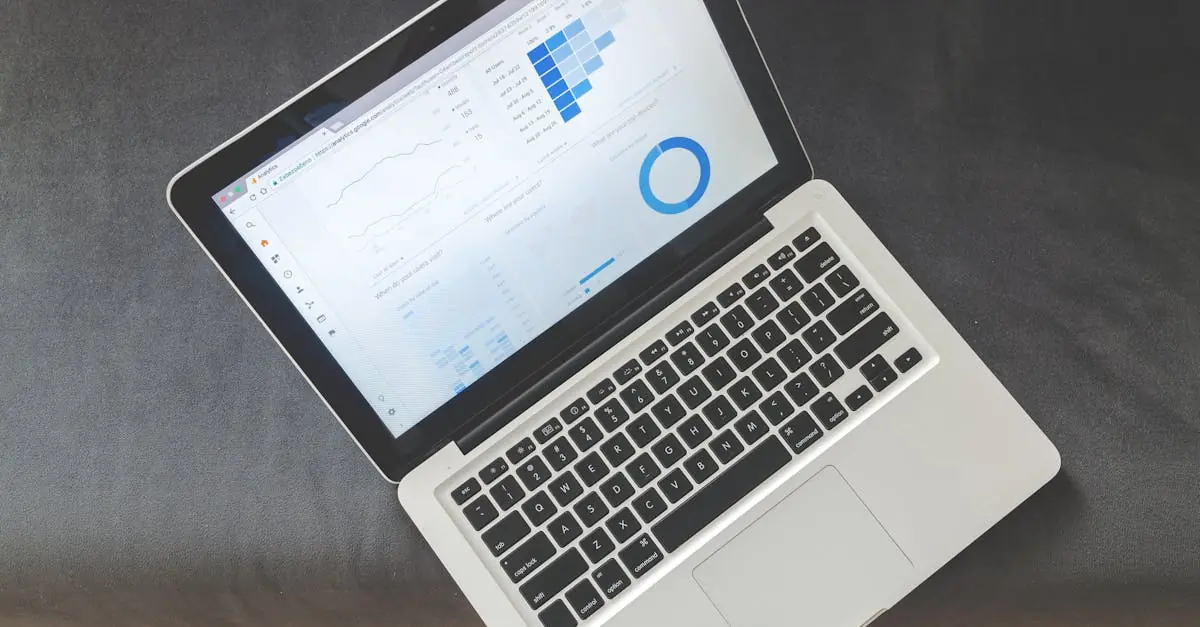In today’s data-driven world, choosing the right analytics software can feel like finding a needle in a haystack—if that needle could also predict your business’s future. With countless options available, it’s easy to get overwhelmed. But fear not! The best analytics tools are here to transform raw data into insightful gold, helping businesses make informed decisions faster than you can say “spreadsheet.”
Imagine effortlessly tracking your website’s performance or uncovering customer trends while sipping your morning coffee. The right software not only simplifies complex data but also turns it into actionable insights. Whether you’re a small startup or a large enterprise, the perfect analytics solution can make all the difference. So buckle up as we dive into the world of analytics software and discover which tools can turn your data dilemmas into success stories.
Table of Contents
ToggleOverview of Best Analytics Software
Selecting the best analytics software involves considering several key features such as usability, scalability, integration capabilities, and the specific needs of an organization. Many top analytics tools offer intuitive dashboards that provide real-time data visualization, making it easier for users to interpret complex datasets.
Global leaders in the analytics space include platforms like Google Analytics, Adobe Analytics, and Tableau. Google Analytics excels in tracking website performance and user engagement metrics, whereas Adobe Analytics focuses on in-depth customer insights through advanced segmentation features. Tableau provides robust data visualization options, allowing businesses to create interactive reports from various data sources.
Evaluating pricing structures is essential, as some software options are available for free, while others require subscriptions or one-time payments. For example, Google Analytics offers a free tier, suitable for small businesses, while Tableau’s pricing starts at $70 per user per month, targeting larger organizations with complex analytics needs.
Consider how well each software integrates with existing systems. Tools that work seamlessly with CRM, email marketing, and social media platforms enhance data collection and analysis processes. This integration capability enables organizations to create a comprehensive view of customer interactions across multiple channels.
Organizations should also assess the level of customer support provided. Responsive support teams can aid in troubleshooting issues and optimizing software use. Training resources, including webinars and documentation, further support effective implementation.
User reviews and case studies often provide insights into real-world applications and outcomes. These testimonials help potential buyers gauge how specific analytics solutions can address their unique challenges and drive meaningful results.
Key Features to Consider
When selecting analytics software, certain features significantly impact its effectiveness. Focus on usability, data integration, and reporting tools to ensure the chosen solution meets organizational needs.
User Interface and Usability
User interface plays a crucial role in analytics software selection. Intuitive navigation enhances user experience, making it easier for teams to access insights. Support for various user levels further fosters engagement, as beginner-friendly designs encourage adoption. Customizable dashboards allow users to tailor the view according to specific metrics, improving interaction and decision-making efficiency. Prioritizing clear visualizations helps users quickly interpret data, reducing training time. Ultimately, usability can dictate the success of analytics initiatives.
Data Integration Capabilities
Data integration capabilities are vital to optimizing analytics performance. Compatibility with various data sources enables seamless data flow from systems such as CRM and ERP. Integration options should include APIs, file uploads, and native connectors for popular platforms. Consideration for real-time data access can enhance responsiveness to market changes. Strong data integration reduces the risk of siloed information, fostering a comprehensive view of business performance. Effective integration leads to actionable insights that support strategic objectives.
Reporting and Visualization Tools
Reporting and visualization tools drive data interpretation and communication. Advanced visualization options enhance understanding through graphs, charts, and heat maps. Custom report generation should cater to specific needs, permitting users to present data clearly. Automated reporting features streamline the analysis process, saving time and ensuring consistency. Accessibility to templates simplifies report creation, facilitating faster insights dissemination. Robust visualization capabilities empower data-driven decision-making across all organizational levels.
Top Recommendations for Best Analytics Software
Selecting the right analytics software strengthens data-driven decision-making. Here are top recommendations with key details.
Software 1: Overview and Features
Google Analytics provides comprehensive tracking for website performance. Key features include real-time data monitoring and customizable reporting. Users appreciate its intuitive interface, which simplifies navigation and enhances usability. Integration with Google Ads enables effective marketing campaign analysis. Pricing options range from free to premium plans based on advanced features.
Software 2: Overview and Features
Adobe Analytics excels in customer insights and segmentation. It offers powerful tools for tracking customer interactions across multiple channels. An advanced machine learning engine predicts customer behavior, enabling proactive strategies. Users benefit from customizable dashboards that present information visually. Pricing typically involves a tiered structure, accommodating various business needs.
Software 3: Overview and Features
Tableau stands out for its robust data visualization capabilities. It transforms complex data into interactive visual representations, aiding interpretation. Features include drag-and-drop functionality for creating dashboards. Users find its ability to connect with numerous data sources particularly beneficial. Pricing strategies vary, offering options for both individuals and enterprises.
Comparison of Pricing Plans
Numerous analytics software options provide varying pricing plans tailored to different user needs. Google Analytics offers a free version that meets the basic requirements for tracking website performance. For more advanced features, its premium version, Google Analytics 360, includes additional functionalities at a subscription cost starting around $150,000 annually.
Adobe Analytics adopts a tiered pricing structure that emphasizes customization based on specific business needs. Costs typically range from $100,000 to $1 million annually, depending on the extent of features and the number of users required. Companies benefit from advanced machine learning capabilities and powerful customer insights aligned with their pricing tiers.
Tableau also presents a diverse pricing model to accommodate both individuals and enterprises. Its Creator plan, ideal for individual users, costs $70 per month, while the Explorer and Viewer plans target organizations, with prices starting at $35 and $12 per user per month, respectively. This flexibility allows companies to scale their analytics efforts according to their data complexity.
When comparing these platforms, understanding the scope of each pricing plan helps highlight key features that justify costs. Google Analytics provides essential tracking tools without financial commitment initially. In contrast, Adobe Analytics demands a higher investment, offering sophisticated analysis capabilities. Meanwhile, Tableau presents varied pricing tiers that support different user levels within an organization.
Pricing factors into decision-making, as organizations evaluate the return on investment relative to feature sets. An informed choice aligns business objectives with specific analytics needs to ensure effective utilization of resources. Each platform’s pricing intricacies serve as a crucial component in selecting the most suitable analytics solution.
Choosing the right analytics software is crucial for any organization looking to leverage data for informed decision-making. With numerous options available it’s essential to focus on features that align with specific business needs. Usability scalability and integration capabilities should be at the forefront of any evaluation.
Top contenders like Google Analytics Adobe Analytics and Tableau each offer unique advantages that cater to different analytical requirements. By carefully assessing pricing structures and user experiences organizations can make informed choices that not only enhance data analysis but also drive meaningful results. Investing in the right analytics software ultimately transforms data into actionable insights paving the way for growth and success.






